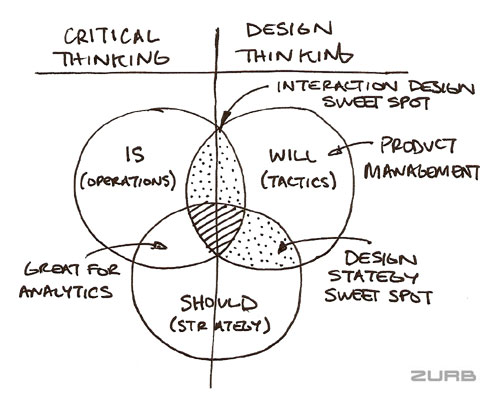Building on my post from yesterday, Is, Will and Should, let's dissect Peter Drucker's Paradigm of Change Model to understand the unique advantages of critical thinking and design thinking in an organization.
Critical thinking is frequently used to solve business problems (an example of an operational role that uses critical thinking is accounting). Looking at the Venn diagram below, it makes sense that most of the IS circle falls on the left side of the chart (critical thinking). Businesses need their operations to run smoothly based on a set formula so that patterns can analyzed. If businesses continually "iterated" on their accounting, payments and receivables would be a mess because transactions would be too hard to track! Standardization is put in place to insure there is a high level of accuracy.

Most businesses validate their strategy through analytics (intersection of IS and SHOULD) instead of relying on tactics (WILL) to drive innovation because it's easier to stay focused on one type of thinking. The problem with this singular, critical thinking model is that strategy is never truly challenged with *innovative* thinking. Design thinking, however, allows a business to inject new ideas without being constrained by the limitations imposed by the operations (IS).
Design thinking has been touted over the last ten years as a new model for solving business problems in an organization. We think design thinking is a great compliment to critical thinking. ZURB's methodologies are heavily rooted in design thinking principles and it's no wonder our sweet spot of interaction design and design strategy fit neatly in the right side of the Venn diagram. It's also not surprising that as interaction designers we're also focused on some critical thinking tasks that overlap with the current operations in a business.
Here are some additional thoughts:
- Design management and interaction design are both evenly divided between critical thinking and design thinking. It's difficult to find talented people that can easily switch thinking caps.
- Most great product managers spend the majority of their time in WILL using design thinking to validate IS while challenging SHOULD. Bad product managers use critical thinking to take SHOULD ideas straight to IS.
- Our buddy LukeW has a nice comparison of critical thinking (business approach) and design thinking (design approach). It's interesting how the business and design approaches in his chart map extremely well to each side of our split Venn diagram.
Dividing this mental framework into two halves makes it easier to visualize which thinking approach is most effective for managing change in an organization.